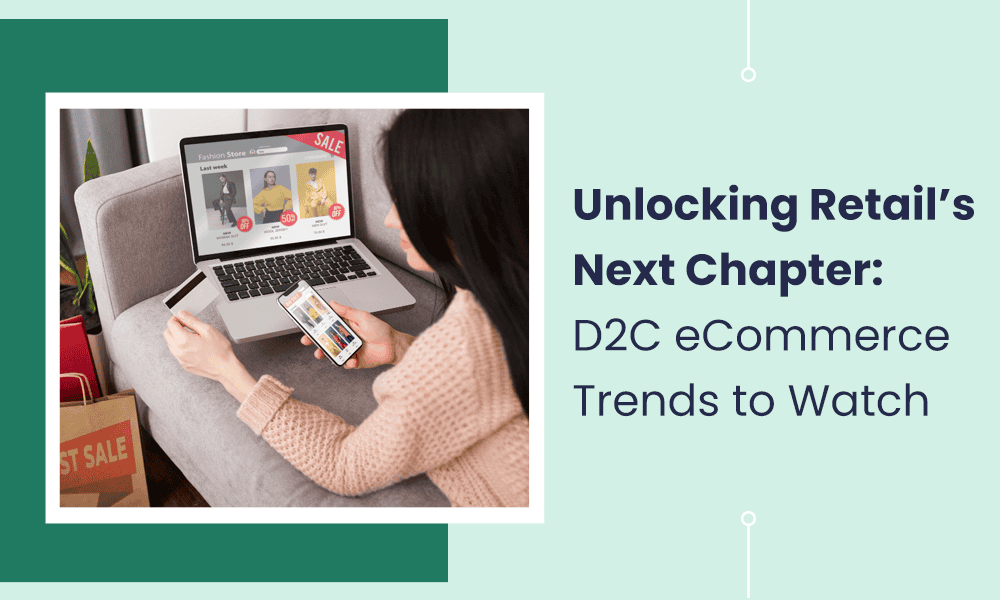The pandemic has changed the landscape of retail and D2C eCommerce for good. In 2020, we saw shutters come down on retail shops across the globe, which led to idle inventory and losses for the industry.
But, the silver lining was the growth of Direct-to-Consumer D2C eCommerce, as companies searched for newer business models and revenue streams in the globalized supply chain management. Even as retailers reopened, businesses quickly recognized the benefits of D2C eCommerce.
With D2C eCommerce, companies could give direct access to their products and quickly market their products. It’s a sure way to provide improved end-to-end customer service.
Businesses have better access to customer data, can make decisions quickly, and act on them. This trend is expected to continue to grow in the future. Companies can no longer focus on just physical stores if they want to stay relevant.
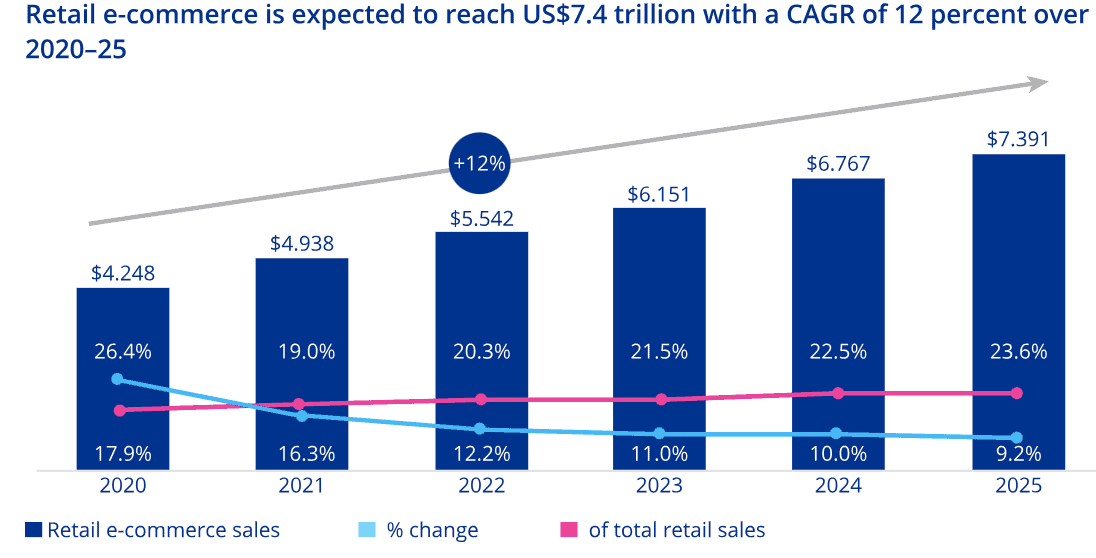
So, we have curated the top six D2C eCommerce trends in one place here.
Moreover, you’ll also get actionable insights on D2C strategy, customer engagement and retention strategies, and case studies. You’ve come to the right place if that’s what you want.
Let’s dive right in.
Table of Contents
Key Takeaways
- The D2C eCommerce market is expected to keep growing in this decade. Companies need to stay ahead of the trends and constantly innovate their strategies to stay competitive in the market today.
- Customization and personalization are expected to play a huge role in 2024. Most customers prefer a tailored, customized online shopping experience and personalized product recommendations.
- Customers expect a greater degree of payment flexibility and options like Buy Now Pay Later or digital wallets. This also serves to boost your sales and reduce cart abandonment rates while giving customers more control over financial planning.
- Companies in 2024 can no longer ignore social commerce integration. Leverage social channels with shoppable posts and influencer partnerships to grab attention where your customers spend most of their time online.
- Customers increasingly expect brands to make sustainable and eco-friendly choices that are ethical. And, they’re willing to put their wallets where their mouths are.
- In 2024, more companies will make use of AI and short-form video content to enhance their reach and grab the attention of customers. This improves your engagement and product discoverability.
- Customers are looking for omnichannel experiences, where they expect a seamless integration of online and offline experiences. Brands are increasingly ensuring that their messaging is consistent across their online platforms as well.
- To leverage these trends successfully, brands can leverage various strategies that work. These include balancing retail and online sales, subscription and loyalty programs, improving data privacy, and investing in the right order management systems.
Key D2C eCommerce Trends for 2024
So, what can you expect in the upcoming year if you’re a D2C eCommerce retailer? Here are our top picks for the trends you must watch out for.
1. Customization and personalization
Who doesn’t love a good, tailored, and customized shopping experience? It ensures that customers feel valued and adds to the overall customer experience with your company. According to surveys, 80% of customers are more likely to buy from an eCommerce company that offers personalized experiences.
This is precisely the sentiment D2C eCommerce marketers hope to leverage in 2024. Let’s face it, today’s D2C eCommerce market is highly competitive.
Customization and personalization are great ways to give your products an edge and let them stand out from the rest.
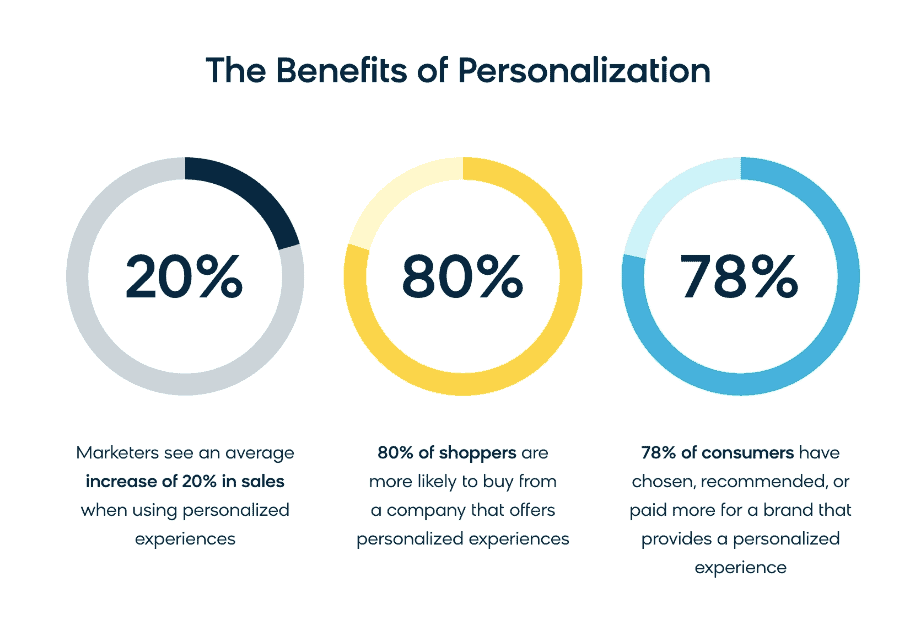
Let’s break it down. With product customization, your loyal customers get product recommendations to suit their unique tastes and preferences. This is where you can leverage customer data to make them feel valued and understood. Personalization goes a step beyond that.
It takes into consideration the customer’s niche interests and purchase history patterns to give them individualized recommendations.
By using strategies like dynamic pricing and increased customer control over their preferences, you’ll be able to leverage this trend to improve customer experience and increase brand loyalty while saving your team’s time and effort.
2. Enhanced payment flexibility
Payment flexibility is the way to go in 2024 and beyond! Let’s look at the statistics. eCommerce companies face a huge issue of cart abandonment. According to a 2024 US survey, cart abandonment rates soared to about 73.14%. This is the general trend across the globe as well.
Here are some of the most common reasons for cart abandonment.
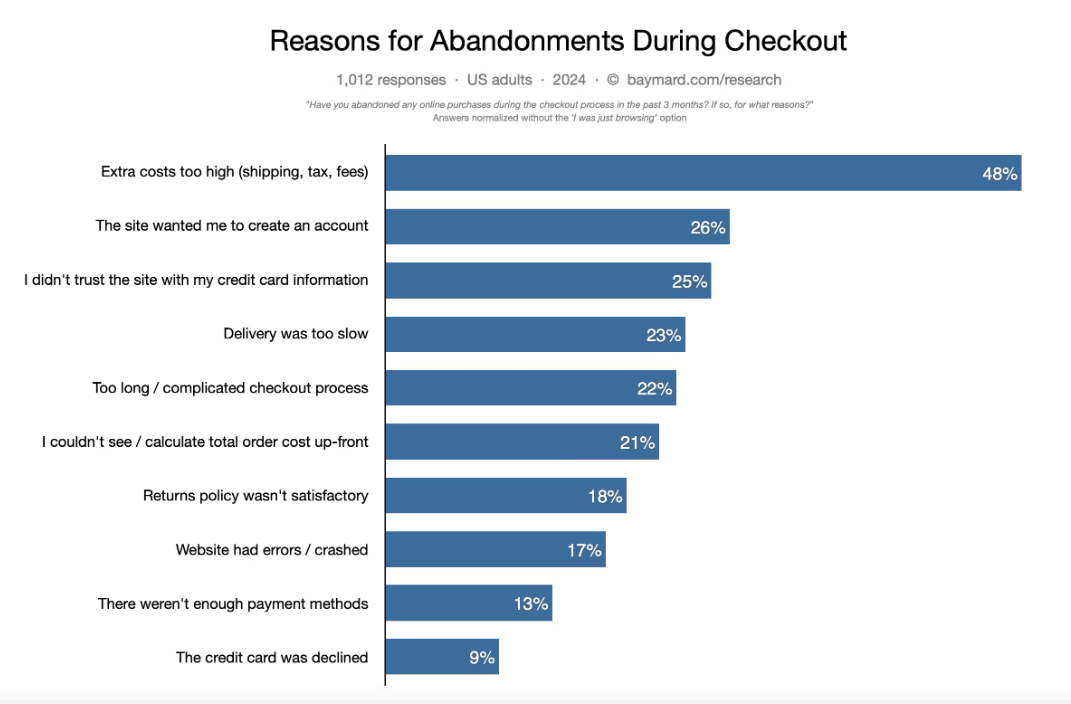
Some of the top reasons are credit card issues and add-on costs. Remember that 67% of millennials and Gen Z don’t own a credit card in the US!
Offering flexible payment plans is a smart solution for both key issues. Consider offering solutions like BNPL (Buy Now Pay Later), where the burden of the collection falls on the third party while you cater to large groups without credit cards. Offering payment options through digital wallets, debit cards, or account-to-account methods is also great.
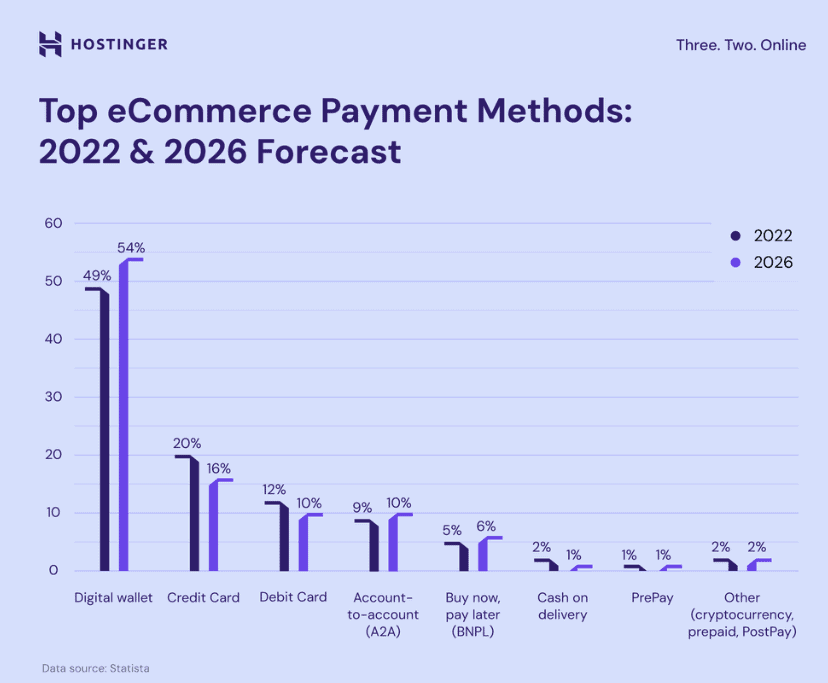
In the next couple of years, this will help you:
- Reduce cart abandonment rate
- Improve overall conversion rate
- Increased brand loyalty
- Improve customer lifetime value (LTV)
- Increased customer acquisition rate
Read also: Best Practices for eCommerce Site Search in 2024
3. Social commerce integration
Social commerce integration is another trend we expect to see take off to more heights in upcoming years. A recent survey by Accenture found that over 59% of the youth would be interested in supporting small and medium eCommerce enterprises through social commerce over eCommerce websites.
In 2024, D2C eCommerce brands are likely to leverage shoppable posts across platforms like Instagram, Facebook, and more. Trust is a crucial factor for customers today. Social channels help you build trust and credibility through user-generated reviews, influencer collaborations, and short-form video content on platforms like TikTok.
Another advantage of social commerce integration is the availability of social listening tools to get real-time feedback on user sentiments and stay on top of emerging trends in 2024 and beyond.
AI-driven insights on customer behavior and AI chatbots on social media channels are also expected to continue growing for the next year. Here are some useful data predictions for the year 2026 in the USA.
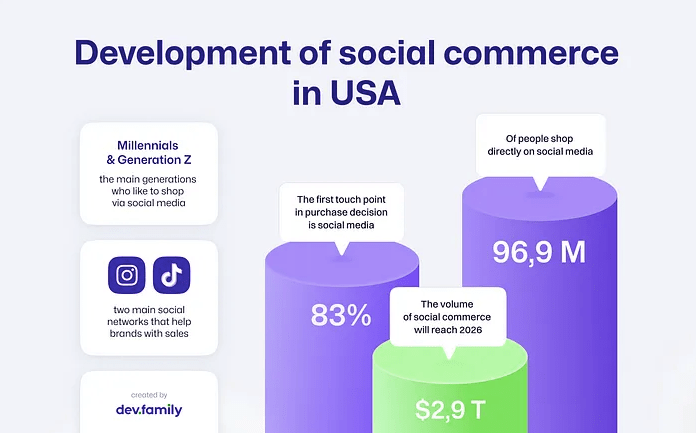
4. Sustainability and ethical practices
With 2024 being one of the hottest years ever recorded in human history, it’s no wonder your customers are highly concerned about sustainability and ethical practices. So, sustainability and building trust through ethical practices will be major factors for D2C eCommerce companies in the coming years.
A recent McKinsey customer sentiment survey found that over 78% of US customers say sustainability is important. They’re ready to put their wallets where their values are, too. However, here are more reasons why sustainability is no longer something D2C eCommerce brands can ignore.
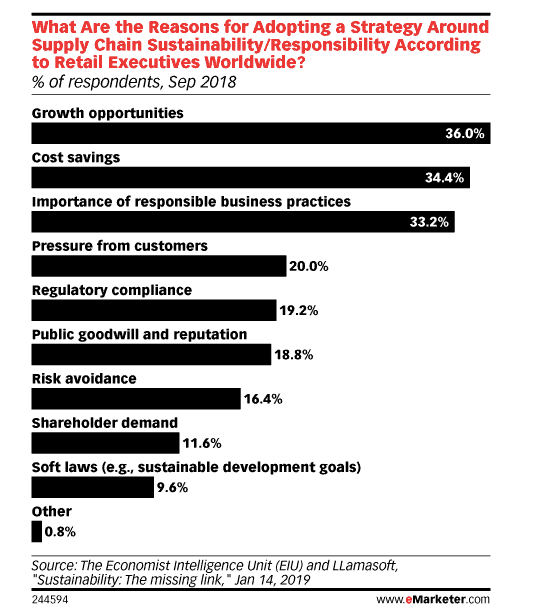
Here are some of the aspects consumers are likely to consider:
- Ethical sourcing of products or ingredients
- Transparency on factory conditions, supply chains, cost breakdowns, and company values
- Eco-friendly packaging
- Industry body and sustainability certifications
- Energy-efficient practices adopted by the brand
- Ethical leadership from corporations, including taking a stand on poverty, climate change, and discrimination
Sustainable practices are a win-win situation for your brand, your consumers, and the environment. Whether it’s your investors or employees, we all stand to benefit when corporations take their Corporate Social Responsibility (CSR) seriously.
We expect to see this translate into increased brand loyalty and cost savings in the long run, too.
5. Advanced technology utilization
With the launch of technology like Apple’s Vision Pro in February 2024, AI-powered tools, integration into the OpenAI universe, and even voice search-enabled shopping are expected to gain traction.
40% of internet users in the US already use voice search regularly! Retailers have begun allowing users to place their orders directly through smart speakers, and more brands are expected to join the bandwagon soon. Here are some of the ways you can leverage advanced technology to boost your D2C eCommerce sales:
- Order management tools can help streamline your inventory management and delivery systems
- Advanced supply chain management tools to boost inventory accuracy, cut costs, and track the end-to-end movement of products in the supply chain
- Improved mobile and web UX design using predictive models that can greatly improve customer experience
- Using predictive analytics to better understand customer behavior and make data-driven decisions to stay ahead of the curve
- Leverage technology to produce short-form video content for social channels like TikTok and Instagram Reels to attract new leads and engage old customers
6. Omnichannel experiences
Looking for a way to bridge the gaps between your physical store, retail store, and social channels? Well, omnichannel experience is a trend that will let you do just that. Here’s a brief overview.
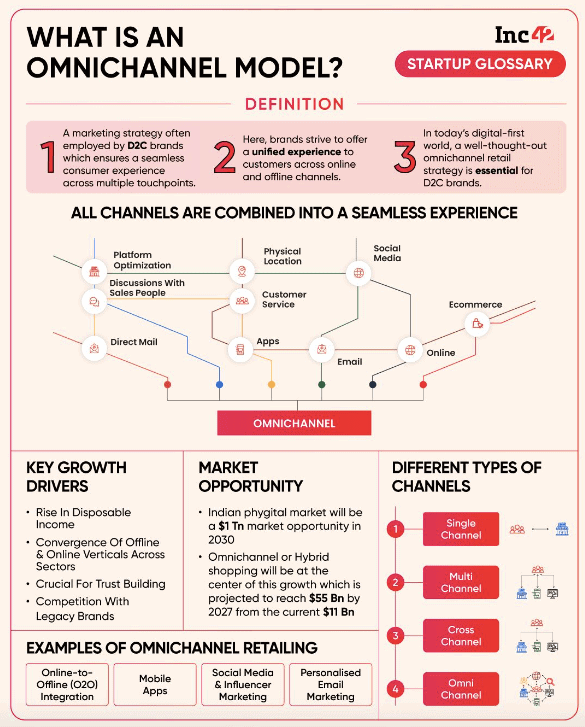
Recent studies point out that over 86% of customers now expect a seamless interaction with a brand over multiple channels. Typically, brands that have already adopted an omnichannel approach tend to get 3.5 times more engagement than competitors without it.
Here are some more reasons why an omnichannel marketing approach is here to stay in 2024:
- Enhanced customer experience and increased brand loyalty due to the integration of online and offline experiences.
- Seamless customer experience, from searching for a product to post-purchase help.
- Broader reach for products and increase overall sales potential for your products across touchpoints.
- A holistic view of customer behavior across channels and better analytics.
- Branding and consistent messaging become easier across key touchpoints and channels.
- Create a real-time feedback loop to remain aligned with changing customer trends, needs, and expectations.
So, those were the major trends that are going to affect the D2C eCommerce industry in 2024. But how would you leverage them and boost your strategy? Let’s break it down in detail.
Read more: 5 eCommerce Email Marketing Software to Help You Sell More
Strategic Insights for D2C Brands
For any D2C brand, it’s your effective and quick decision-making that lets you stand out from the rest in the highly competitive market. And, let’s not forget. If you’re a new player venturing into the murky waters of D2C eCommerce marketing, you face two key issues:
- Convincing your existing partners and stakeholders about the expected benefits of D2C eCommerce
- Navigating the complex and ever-changing eCommerce market that’s very competitive
So, we’ve curated some top strategic insights to help your brand make the right decisions whether you are a small or medium-sized enterprise. Let’s dive right in.
1. Balance retail and online sales and build credibility
Let’s face it. Your retail partners or distribution partners may not be able to fully appreciate your transition to D2C eCommerce. This is especially the case when you’ve had a robust business partnership with them.
So, rather than rushing into the new model, you might consider beginning your transition to D2C eCommerce with a hybrid model. This can include components of both D2C and traditional distribution models. At the same time, your focus should now shift to building long-term, sustainable relationships with new customers.
After all, it is their brand loyalty and patronage that will help both you and your stakeholders grow into the D2C eCommerce industry and grow your profits over the years. Here are our top tips:
- Design your websites and social channels with the goal of seamless integration and resolving customer pain points.
- Keep a healthy balance between retail and D2C selling, especially if you’re a small business.
- Focus on building a D2C platform that is scalable and can handle growth spurts. Ensure compliance with local and international laws.
- Use social channels to attract customers and engage old ones. Use an omnichannel approach to improve customer experience.
- Highlight your brand values and mission with honesty and transparency. Showcase how you’re contributing to sustainability as well.
- Dedicate a team to your analytics and constantly update your strategies based on real-time feedback.
2. Implement the right product selection strategies
Without the right product selection strategies, you’ll find costs quickly escalating for your D2C brand. First, you’ll need some solid market research in your niche. What are some customer pain points that you can tackle?
Decide on your product mix based on these considerations as well as logistics. Remember, launching too many new products too fast can spell disaster. We would suggest offering a few new products as a test run on your D2C website. This way, you’ll have clear insights to offer distributors on which products will be flying off the shelves and which ones may not.
Consider creating a few, select new products that you can launch online exclusively. If there are some products that traditional retailers may be unwilling to stock, your D2C channel can give you real-time data on the demand for these products.
3. Consider implementing an effective revenue-sharing program with partners
A revenue-sharing program may not get you a huge profit margin immediately, but it will reap a lot of rewards in the long run. How can you do this?
It’s simple. Allow your retailers to offer exclusive merchandise or exclusive offers that are not available on your online store. That’s one way. Alternatively, you can offer kickbacks and perks to your retailers whenever they refer customers — even less profitable ones. This way, you ensure that your retailers add value to your brand and vice versa.
4. Get clear on your USP and evolving customer pain points
The D2C market is evolving rapidly, and it is also highly saturated. And in the post-pandemic era, customer preferences and pain points also continue to evolve rapidly.
So, creating and highlighting your Unique Selling Point (USP) can help you navigate the choppy waters of D2C eCommerce like a seasoned sailor. Get clear on what qualities and strengths make your company stand out from the rest.
Further, focus on customer-centric innovation at all times. This means creating a real-time feedback loop where you’re constantly taking customer feedback into account and innovating your D2C eCommerce strategies based on it.
Read more: Winning in a Competitive World — eCommerce Marketing 101
Customer Engagement and Retention Strategies
D2C eCommerce brands cannot succeed in the long run without effective customer retention and engagement practices. It forms the very backbone of your success story. Here are our top strategies you can implement today.
1. Provide seamless pre-purchase and post-purchase customer experiences
Customers expect a seamless omnichannel experience and a smooth purchase experience from your D2C brands. This is a key strategy you cannot afford to ignore. Here’s how you can implement it.
Pre-purchase strategies
- Create a user-friendly website and mobile app and facilitate a smooth omnichannel experience for customers.
- Ensure faster loading times. Run several A/B tests on your website and mobile app to ensure a hassle-free experience.
- Provide high-quality images and explainer videos on your products to facilitate quick decision-making. Additionally, include detailed, honest, and comprehensive product descriptions, including details on warranty, sizing information, product care, and materials used.
- Include a comprehensive FAQ section covering most of the customer pain points and ensure it is easily accessible.
- Include plenty of customer reviews and review videos to build credibility and highlight happy customers.
- Provide a live chatbot to answer customer queries in real-time. Customers should be able to connect with an agent in case of queries. Try to reduce the wait time for customers and tackle their queries as quickly and effectively as possible.
Post-purchase strategies
- Send instant confirmation emails or texts with a detailed breakdown of their purchase and expected delivery date and time.
- Use sturdy, reliable, and eco-friendly packaging for your products. It’s a way to let your brand values of sustainability shine.
- Implement a hassle-free and quick return policy in case a customer is unsatisfied with the product. Provide live chat support to customers wishing to return products. Consider offering a prepaid return label to save customers time and energy.
- Use post-purchase emails to cross-sell and upsell related products. Offer limited-time, exclusive discounts to boost engagement.
- Respond immediately to poor feedback and offer quick solutions for the same. This shows accountability and builds customer relations.
2. Go beyond transactional relationships with customers
Your D2C eCommerce brand has to rely on a core set of repeat customers to become highly successful. Why?
There’s a simple reason, explained in a recent McKinsey survey. Retaining a customer costs 5x less than acquiring a new one! So, your strategy has to strike a crucial balance between customer retention and customer acquisition. Here are some statistics to help you build your retention strategy.
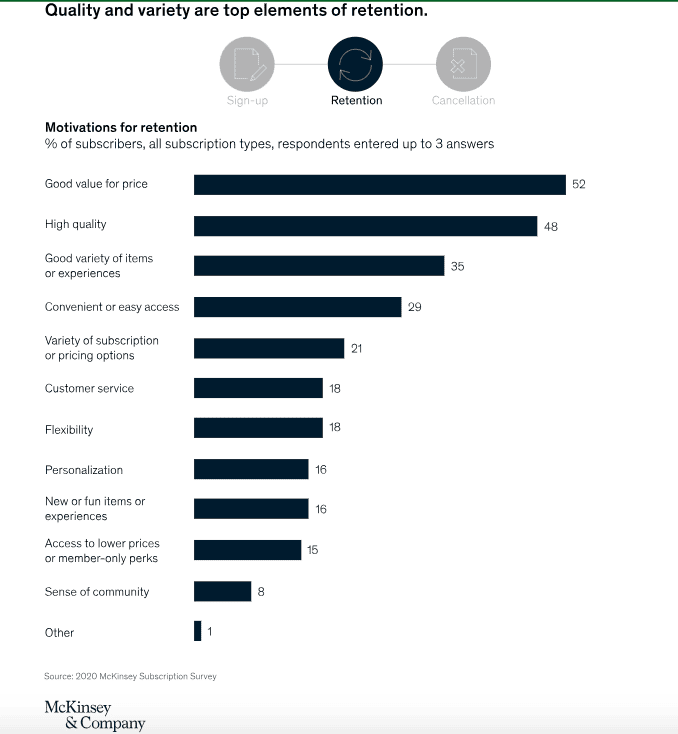
One proven method to increase customer retention is to roll out a subscription program. Remember that customers are increasingly getting used to promotions. But, providing a tiered subscription program can help you prevent churn. Customers can choose to downgrade to a less premium subscription plan instead!
But remember that even the best subscription plan won’t work if you’re unable to add value to the customers for the prices you charge. Ensure a good variety of products and experiences for customers to retain them in the long run.
If a subscription policy isn’t for your brand, then consider a loyalty program instead. If you’re able to implement it successfully, studies show that customers are 80% more likely to buy from your brand through the loyalty program. This can be achieved by offering not just discounted prices, but offering a variety of benefits and new experiences for loyal customers.
3. Build trust with customer data privacy and transparency
Customers increasingly value their data privacy when making purchases. This benefits your brand as well. By the end of 2024, Gartner studies show that 74% of the world’s population will be protected by data privacy laws in their countries.
Any company that violates these laws is likely to face several fines or restrictions. So, it is also in your interest to stay ahead of the curve and establish yourself as a trusted brand by ensuring data privacy. Adults across the US take their data concerns seriously, as you can see from this infographic.
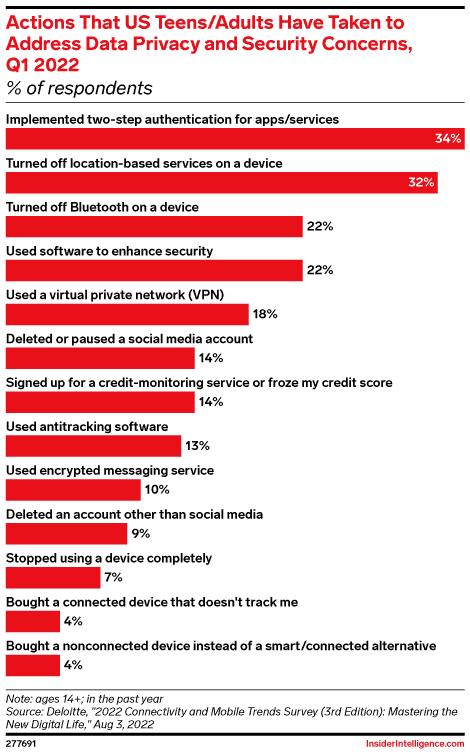
So, it pays off to invest in cyber security policies for your company and protect long-term customers from possible data breaches. This will give you an edge over competitors as 2024 draws to a close soon.

4. Invest in improving your order management systems
Inventory and order management systems form the cornerstone of a successful D2C eCommerce venture at any stage. We can’t overstate the importance of these two factors.
According to a recent survey, 98% of customers say the delivery experience affects their brand loyalty to an eCommerce store. In another survey, over 85% of customers stated that one poor delivery experience would prevent them from ordering from that eCommerce brand again.
Here are some of our best practices for order management:
- Constantly improve your order processing efficiency. Use an Order Management Software (OMS) that can give you real-time data on this. Continuously measure your processing efficiency against industry and product benchmarks.
- Improve your order tracking process and provide several communication avenues for customers. Invest in a reliable shipment tracking solution or partner with a reputed shipping company.
- Ensure you have the best quality control procedures. This includes training staff at all levels to nitpick frequent issues with the packaging and have a system to ensure all orders are checked thoroughly before shipping. Create a solid order processing workflow and automate certain tasks to avoid human errors. This would reduce returns in the long run, too.
- Use your OMS system to automate shipping return label generation. This ensures a hassle-free return experience for customers should they wish to return the product. At this stage, recording user feedback is also crucial to improve your order management process.
- Plan your OMS and order processing workflow for scalability and automation. This can give you a solid foundation. You can also ensure that order processing won’t hinder your growth even if you start receiving a larger order volume.
Related article: 25 Top eCommerce Marketing Tools to Boost Sales
Case Studies From D2C eCommerce You Can Learn From
Now, let’s take a look at some case studies and success stories from D2C eCommerce stores that have successfully leveraged some of these strategies to grow their business.
1. The Dollar Shave Club’s membership program & videos
The Dollar Shave Club wasn’t always such a famous brand.
When launching the company in 2011, founder Mark Levine had identified one key problem in the razor market in the US — the lack of cheap razors. At this time, big brands like Gillette had a near-monopoly over the market which led to a rise in markups.

Levine identified his target audience clearly — people in their twenties and thirties who struggled to afford the premium razors. They streamlined their marketing strategies and business model for this group and saw a grand success.
They launched a business model that combined a trading model and a subscription model that was quite new at the time. This gave subscribers the option to buy a razor for just one dollar, and the subscription model gave them an easy option to get replacement razors every month after that.

They also leveraged the power of video marketing, with their viral video ad gaining over 4 million views within weeks of its launch. This single video gained them over 12,000 new subscribers within two weeks! These steps helped establish them as a trusted brand and shot up their organic search hits.
2. Ritual’s success with customer experience and community building
Rituals is a brand that opened its stores in Amsterdam in the early 2000s. Since then, they’ve expanded into a multi-national chain with stores from Paris to New York. They were able to successfully expand into the D2C eCommerce market with an average revenue of $956 million!
Ritual’s success comes from its successful brand positioning and USP. They sell products in a niche that’s highly competitive and saturated, such as scented soaps and candles, body lotions, and moisturizers. Here’s what Raymond Cloosterman, their CEO, says about their brand philosophy.

But, they’ve successfully espoused a sustainable and eco-friendly approach. And, what better way to stay true to their company values than by giving back to the community? Here’s their brand positioning on their home page.

Apart from that, they’ve seen immense success with social media channels. They’ve successfully collaborated with several micro-influencers with 15K-50K followers on average instead of going behind big names.
They’ve also generated a large number of User-generated content on Instagram, TikTok, and YouTube, making them seem very down-to-earth and community-based.
On all their social channels, they regularly livestream mindfulness practices to encourage their loyal customers to take a breather from their busy schedules.
Read more: 19 eCommerce Best Practices to Win Customer Confidence
Conclusion
While the D2C eCommerce market comes with its unique set of challenges, it is also one of the most lucrative markets today.
By leveraging upcoming trends in 2024, like personalization, embracing social commerce, sustainability, and ethical practices, companies of all sizes can continue to thrive in the market.
We hope the case studies also inspired you to implement some of these upcoming trends to stand out from competitors and keep scaling your D2C eCommerce store well into the future.
Let us know what inspired you in the comments below.
FAQ
What is D2C eCommerce?
D2C eCommerce stands for Direct-to-consumer eCommerce, which is a digital business model where the products reach the consumers directly without relying on middlemen or middle distribution channels.
The traditional model for businesses goes from the manufacturer to wholesalers and distributors before reaching a retail store. D2C eCommerce removes these distribution channels to reach consumers directly.
Brands like Warby Parker, Casper, and the Dollar Shave Club are popular examples of this model.
Why is personalization important in eCommerce?
A majority of consumers today expect a personalized and customized experience across various touchpoints. This ranges from personalized product recommendations based on past behavior to personalized discounts and offers to loyal customers.
Personalization also offers improved customer experience and satisfaction. It also improves brand loyalty and customer lifetime value.
What are the benefits of flexible payments for eCommerce?
Flexible payment solutions like Buy Now Pay Later (BNPL) and digital wallets allow consumers to manage their cash flow effectively. This means a D2C eCommerce brand offering these payment options can encourage customers to purchase more in a given month, and sell more of high-demand products. In the long run, it also increases customer retention and brand loyalty.
How do sustainability practices impact D2C brand loyalty?
A growing number of consumers expect D2C eCommerce brands to adopt sustainability practices like eco-friendly packaging, ethical sourcing of products, and energy-efficient practices. In the long run, this serves to build brand loyalty and enhance the brand’s reputation.
